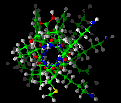 Energy
Database
Energy
Database Energy
Database
Energy
Database Jump to Descriptions of Contents or of Accessing the
Database or Examples; explanation of how
keywords are documented.
Jump to Descriptions of Contents or of Accessing the
Database or Examples; explanation of how
keywords are documented.
Name (type string) Parent (type rid) Value (type double) Print (type short)Thus, a row specifies the name of an energy term, its immediate parent, and the numerical value of the energy term. The Value column is updated after every energy calculation. The Print column is used to control the output of rows with an energy value of 0.0 (see the examples below).
The purpose of the Parent column is to define a hierarchy of energies. For example, Bond energy is a child of Internal energy. All children of Internal energy are summed to form the total value for Internal energy. Therefore, only leaves on the tree (i.e., final ends, or rows with no children referring to them) are independent energy values. These values are extracted from the current energy calculation and recursively summed into their parents to finally provide the Total energy row.
Coord (type double) Gradient (type double) Nonbond-A (type double) Nonbond-B (type double)These columns contain the coordinates, gradients, and the nonbond parameters A (or r) and B (or
The energy database is deleted when the Discover program is finished running or when a reset or begin command is issued.
BTCL > database handle ener_h Energy.
BTCL > energy
BTCL > $ener_h print Values
"Values"
{
Row Name Parent Value Print
--- ----------------- ------ ------- -----
0) Total . -18.530 0
1) Internal 0 5.607 0
2) Bond 1 2.759 0
3) Angle 1 2.849 0
4) Torsion 1 0.000 0
5) OutOfPlane 1 0.000 0
6) Cross 1 0.000 1
7) BondBond 6 0.000 0
8) BondAngle 6 0.000 0
9) EndBondTorsion 6 0.000 0
10) MiddleBondTorsion 6 0.000 0
11) AngleTorsion 6 0.000 0
12) AngleAngleTorsion 6 0.000 0
13) BondBond-1-3 6 0.000 0
14) AngleAngle 6 0.000 0
15) Nonbond 0 -24.137 0
16) Vdw 15 3.727 0
17) Repulsive 16 8.964 0
18) Dispersive 16 -5.237 0
19) Electrostatic 15 -27.865 0
20) Hydrogenbond 15 0.000 0
21) Restraint 0 0.000 1
22) External 0 0.000 1
23) Diffraction 22 0.000 0
}
Other commands that request energy printout, e.g., energy print
energies = 1, use the data stored in the Values table to
form a hierarchy of energy values:
Energy components kcal/mol
Total: -18.530128
Internal: 5.607232
Bond: 2.758628
Angle: 2.848604
Torsion: 0.000000
OutOfPlane: 0.000000
Nonbond: -24.137360
Vdw: 3.727446
Repulsive: 8.964310
Dispersive: -5.236864
Electrostatic: -27.864806
Hydrogenbond: 0.000000
Additionally, the Print column dictates how 0.0 values are
collapsed:
If the value is: Then
0 Always print the term.
1 Look at the term and its descendants and
print them out if any of them are not zero.
2 Do not print the term; do not look at its
descendants.
BTCL > database handle ener_h Energy. BTCL > energy print first_deriv = 1 print second_deriv = 1 BTCL > $ener_h get hess Misc.Hessian BTCL > Utility_CastHessianMatrix hess BTCL > vector e_values diagonalize -eigenvectors e_vectors $hess BTCL > echo eigen-values= [vector e_values] BTCL > echo eigen-vectors= [vector e_vectors]
BTCL > database handle ener_h Energy.
BTCL > set fileHandle [open electrostatic.list w]
BTCL > proc getElectrostaticEnergy {ener_h} {
$ener_h select Electrostatic Values.Name row_n
$ener_h get e_energy .Value $row_n
return [object e_energy]
}
BTCL > minimize \
execute frequency = 10 \
command = {puts $fileHandle [getElectrostaticEnergy $ener_h]}
BTCL > close $fileHandle
BTCL > System_SetGlobal internalEnergyDecomposition 1Any subsequent energy evaluations tabulate the individual energies and derivatives in the Bond, Angle, Torsion, and Oop tables of the Energy database.
BTCL > energy
BTCL > database handle edb Energy.
BTCL > $edb print Bond
"Bond"
{
Row Atom1 Atom2 Energy dE/dBnd
--- ----- ----- -------- -------
0) 0 1 0.04539 8.046
1) 0 2 0.00180 1.816
2) 0 3 0.00023 0.644
3) 1 4 0.00458 2.498
4) 1 5 0.03620 6.403
5) 1 8 0.00117 1.230
6) 5 7 0.00386 3.082
7) 5 6 0.00006 -0.297
8) 8 9 0.00088 1.093
9) 8 10 0.00167 1.507
10) 8 11 0.00155 1.191
11) 11 12 0.00070 0.875
}
The example above shows the decomposition of the bond internal energy.
These energy values include the bond energy as well as the
contributions from the bond crossterms. Each crossterm energy is
distributed completely into the internals that make up the crossterm.
For example, a bond/angle crossterm contributes half of its energy to
the bond and the other half of its energy to the angle. Below is a
summary of how each of the crossterms' energies are factored:
bond-bond 1/2 bond1 1/2 bond2
bond-angle 1/2 bond 1/2 angle
angle-angle 1/2 angle1 1/2 angle2
bond1-torsion* 1/2 bond 1/2 torsion
bond2-torsion+ 1/4 bond1 1/4 bond2 1/2 torsion
angle-torsion 1/2 angle 1/2 torsion
ang-ang-tors 1/3 angle1 1/3 angle2 1/3 torsion
* middle-bond/torsion crossterm
+ endbond-torsion-endbond crossterm
There is a little overhead in bookkeeping for the decomposition;
therefore, when the energy breakdown is no longer needed, the option
should be unset with:
BTCL > System_SetGlobal internalEnergyDecomposition 0
 Main
access page
Main
access page  Advanced-Use access.
Advanced-Use access. Copyright Biosym/MSI